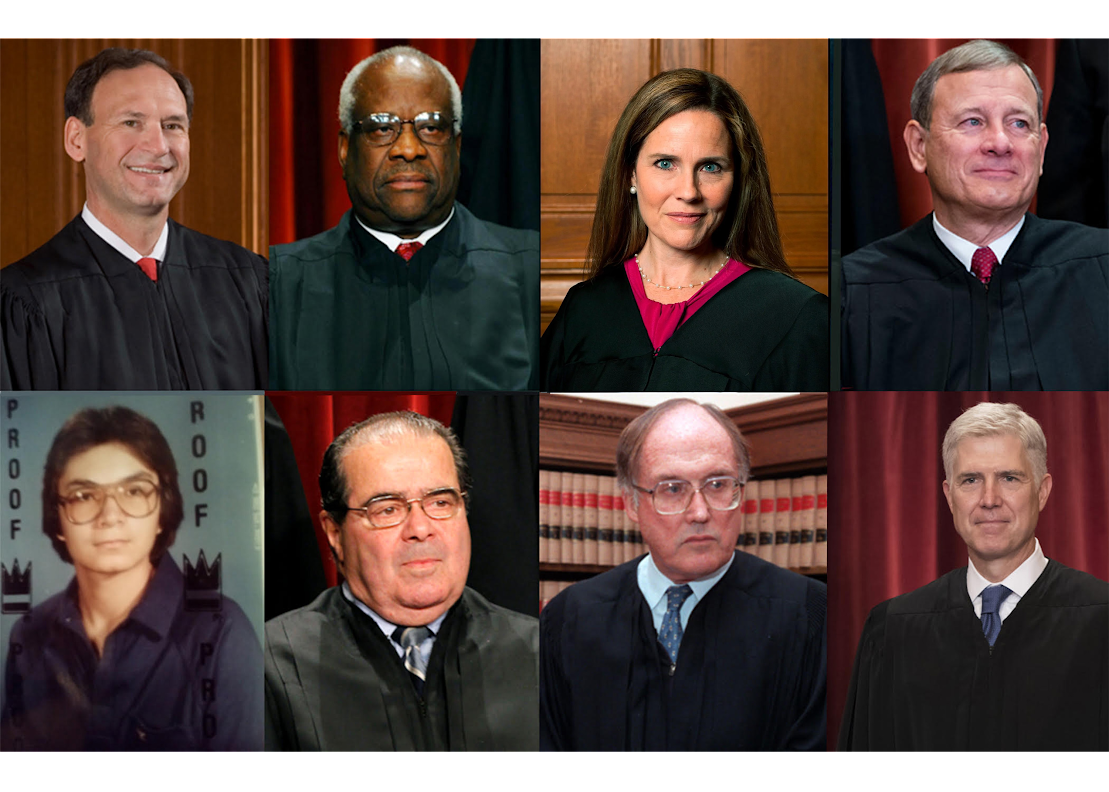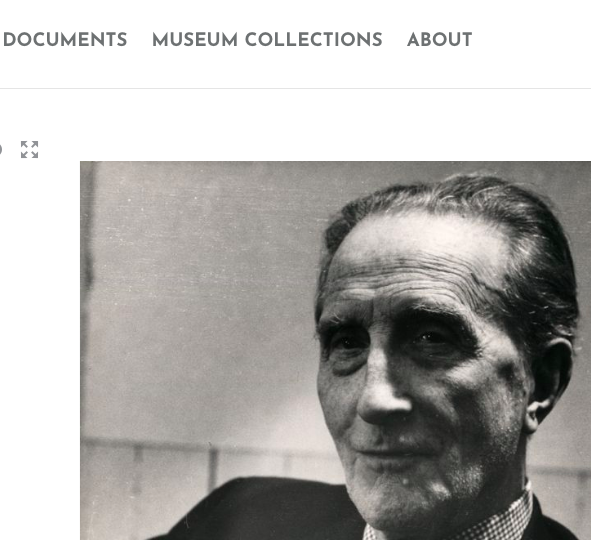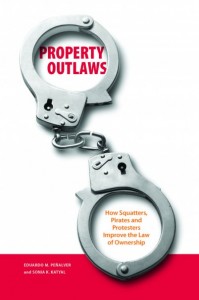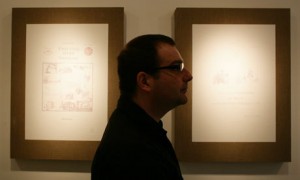You have legal notice. So says Print Magazine’s February issue. I subscribe to Print magazine and like it quite a bit. If you’re overwhelmed with reading material but wish to keep up with graphic and print design, Print is a great one-stop source. Anyhow, as I was reading this on the subway the other day I noticed something quite peculiar in this particular issue: there were two advertisements and one article dealing only with the subject of trademark and contract law.
Will textualism save our copyright planet? Warhol Fdn v. Lynn Goldsmith headed to SCOTUS
Images of Goldsmith and Warhol at issue. The U.S. Supreme Court will review a ruling that an Andy Warhol print infringed a copyrighted photograph taken by photographer, Lynn Goldsmith, of the late musician, Prince. We certainly hope--as much as one can hope for anything these days--that SCOTUS cleans up the wasteland that has become of "fair use" interpretation. One would think, and hope I suppose, that with many of the sitting justices adhering to textualism, they will fully jettison the nonsensical "transformativeness" test that has plagued us like a really bad case of Covid since the mid-1990s. Docs here, via ...


Podcast: Stephanie Drawdy and Sergio Munoz Sarmiento on All Things Art and Law
Ahh...Youth! Sergio Munoz Sarmiento. (2015 - ongoing), C-Print. © and TM Sergio Muñoz Sarmiento. All rights reserved. I had a lovely conversation with fellow lawyer and artist, Stephanie Drawdy, on the NFT craze, pets, art law, and the origins of The Art & Law Program. You can listen to the Podcast here. Hope you enjoy!


Marcel Duchamp archives now online, free of charge
The Philadelphia Museum of Art, the Centre Pompidou, and the Association Marcel Duchamp have digitized their vast archives of material on the Dadaist and placed it online, where it is free to all. Enjoy!


The Art & Law Coloring Book
If you have kids at home and want them to do something fun and educational, try the Art & Law Coloring Book, an ongoing project by The Art & Law Program. Really a great collection of drawings by great artists, including: Emma Jane Bloomfield Damien Davis Molly Dilworth João Enxuto Soda Jerk Clare Kambhu Alexandra Lerman Erica Love Douglas Melini Sergio Muñoz Sarmiento Melinda Shades Elisabeth Smolarz Gabriel Sosa Alfred Steiner Valerie Suter Happy coloring!


What are NFTs and what does it mean to own one?
If you're confused as to what the hell NFTs are, particularly art NFTs, here's a new article by Alfred Steiner that pretty much walks you through and safely out of the NFT hell. In his article, Steiner explains what NFTs are and what it means to own one. He also discusses why that meaning of ownership—which may appear novel to many—isn’t new at all when considered against the backdrop of the market for conceptual art. Steiner concludes with some observations about how NFTs may be good and bad for the art industry.


And what if you’re an artist like me who also keeps large and original digital files of images, video, and research material in your inbox, what happens then? The Atlantic’s Jeff Goldberg has an answer, albeit a bit sad.
If you suspect that you’re going to die soon, I suggest that you print out important correspondence, or share your password with a loved one. If you have a Yahoo e-mail account, no one will be allowed access to it, so your contacts will have to be notified of your death some other way; the company will permanently delete your e-mails when it receives a death certificate. Gmail is a bit more generous. Your legal representative will be allowed access to your account when proof of death is provided. AOL also transfers the e-mail account to your designated representative upon receipt of a death certificate. The new user will have the option of sending out a death notice, or simply deleting the account. Individual companies have different policies, of course.
You’re a visual artist and as such you spend considerable amount of time, energy, and money researching an art project. You conceptualize and sketch out an idea for that art project, and sometimes actually make models, maquettes, sculptures, paintings, videos, films, and yes, even installations in your own studio. You invite people over: friends, curators, artists, writers, and critics, and naturally feel inspired by their feedback and critiques (hopefully positive). Some artists are students, so the requisite studio-visit from full-time faculty, adjunct faculty, and visiting artists are mandatory. You regroup and feel ready to exhibit your art work.
Then, the unexpected happens. You see your artwork in someone else’s exhibition, and sometimes in some art journal or web media source. The nauseating feeling that arises is followed by disappointment and anger. To call this a traumatizing experience would be an understatement. Unfortunately, we’ve all been there and had this experience. To be sure, there are ethical, moral, and yes, legal issues that arise. So what do you do?
Do you pursue this through legal means? Do you sue the “infringer,” or do you send a cease and desist letter? Are there other avenues where ethical and moral factors can give you better protection? Do you contact the “infringer” and try to settle the dispute? Do you contact the exhibition venue or print or web journal?
But if you take the legal route, under what laws? Does it matter if they took only the idea and not an exact replica? What if you just told people about your idea but otherwise did not materialize anything? What if they gave you credit? What if it’s your friend, your collaborator, your teacher, or the visiting artist? Does this change the situation, and if so, how? What if you’re a student or, a fellow in an artist resident program?
I ask more questions than posit solutions because in effect, the basic question is: what are you rights, and what do you (actually) own. It would be a waste to ask why anyone would “steal” the idea of another artist, not to mention an art student. This is good fodder for a class in ethics and morality, but otherwise insufficient to resolve our frustrating dilemma, what do you do?

Yale University Press has just published a book, Property Outlaws: How Squatters, Pirates, and Protesters Improve the Law of Ownership, by two good friends of mine, Sonia K. Katyal and Eduardo Moisés Peñalver, on disobedience and law. The book focuses on tangible and intellectual property, and is already being praised by some mighty academics such as Tim Wu at Columbia Law, Rebecca Tushnet at Georgetown Law, and Jonathan Zittrain. Harvard Law guru Joseph Singer calls this book “A major achievement”. Here’s a blurb from Yale Press:
Property Outlaws puts forth the intriguingly counterintuitive proposition that, in the case of both tangible and intellectual property law, disobedience can often lead to an improvement in legal regulation. The authors argue that in property law there is a tension between the competing demands of stability and dynamism, but its tendency is to become static and fall out of step with the needs of society.
The authors employ wide-ranging examples of the behaviors of “property outlaws”—the trespasser, squatter, pirate, or file-sharer—to show how specific behaviors have induced legal innovation. They also delineate the similarities between the actions of property outlaws in the spheres of tangible and intellectual property. An important conclusion of the book is that a dynamic between the activities of “property outlaws” and legal innovation should be cultivated in order to maintain this avenue of legal reform.
I interviewed Eduardo back in 2006, where he talks about property law, the legal differences between real and intellectual property, and the relationship of these discourses to art and cultural production (as well as his i-Pod mix). You can order your copy from Yale University Press or Amazon.com
Judith Dobrzynski, a former reporter and editor at the NY Times, wrote yesterday on a very interesting alternative to the deaccessioning fight. In brief, she argues for an “impartial arbitrator,” which would hear a museum’s argument and need for deaccessioning art to pay the bills.
Maybe it’s best to amend the unwritten sales ban, but not end it. What if a museum had to argue its case for de-accessioning art before an impartial arbitrator? This neutral party would need to be schooled in art, art law and nonprofit regulations. [bold mine]
If done properly, this is actually the best solution put on the table so far, and to my delight (and self-serving position) something not too far from what I have argued on my Deaccessioning Blog.
THE squeeze is on. Museums everywhere are having trouble making ends meet, what with the overblown expansions they’ve made, the decline in investment income and the steep drop-off in contributions from foundations and individuals. Many have cut staff, frozen pay, trimmed exhibition schedules and slowed or stopped acquisitions. For some, that may not be enough: the American Folk Art Museum, to cite one example, recently admitted that it isn’t making debt payments.
Dobrzynski seems to be reigniting, in an academic and open town-hall-meeting of sorts, the deaccessioning debate started in early 2009 over the Rose Art Museum, and being the first in 2010 to realize that the museum economic disasters are intensifying and not-at-all decreasing. She sites others on her corner with similar thoughts.
What’s next? In some corners, there’s fear that museum officials will do what is absolutely forbidden by art-world rules: raise operating cash with a sale of artwork. Already some respected figures — David Gordon, former head of the Milwaukee Art Museum, and Richard Armstrong, director of the Solomon R. Guggenheim Museum, for example — are saying that the rule against selling art for any purpose other than buying more art is wrong.
What do you think? Deaccessioning Arbitration and Regulation Panel (DARP)? That’s my vote! Good start for 2010. Judith’s article in its entirety here.
UPDATE: January 4, 2009
Judith has a few more thoughts on her op-ed on her blog, and here are my thoughts regarding lawyers as arbitrators.

The UK’s Metropolitan Police have warned Greek artist Xenofon Kavvadias that he may be arrested and prosecuted under the country’s Terrorism Act “if he mounts an exhibition featuring texts such as The Islamic Ruling on the Permissibility of Martyrdom Operations, a justification for suicide bombings used by Chechen extremists.” Via the Guardian.
Clancco, Clancco: The Source for Art & Law, Clancco.com, and Art & Law are trademarks owned by Sergio Muñoz Sarmiento. The views expressed on this site are those of Sergio Muñoz Sarmiento and of the artists and writers who submit to Clancco.com. They are not the views of any other organization, legal or otherwise. All content contained on or made available through Clancco.com is not intended to and does not constitute legal advice and no attorney-client relationship is formed, nor is anything submitted to Clancco.com treated as confidential.
Website Terms of Use, Privacy, and Applicable Law.

